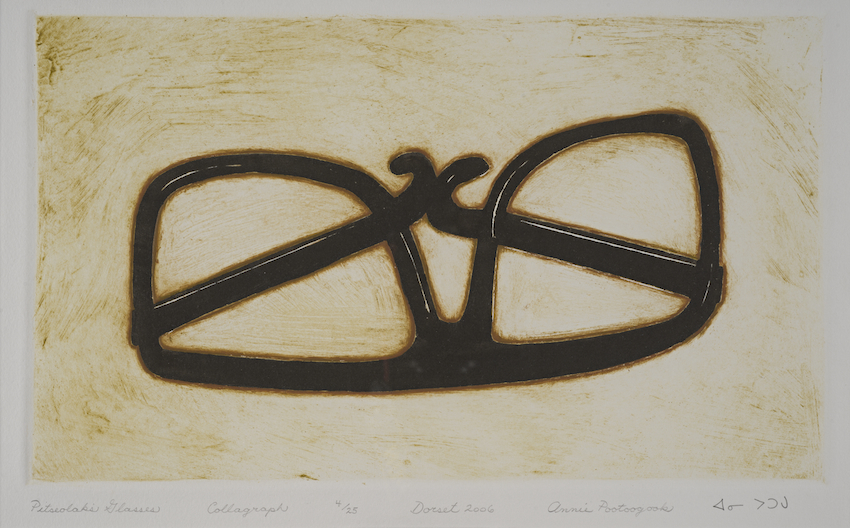
Annie Pootoogook, (Inuit, Cape Dorset, Canada, b. 1969)
Pitseolak’s Glasses, 2006
Collagraph (edition of 25)
13 x 20 inches
Reproduced with the permissions of Dorset Fine Arts
“I used to go see my grandma drawing. They used to talk about what they are doing about life in the past. She used to tell the stories that came with the drawings and those were true stories. I wish I was born in the past. I would know in the traditional ways. I only know by my mom’s drawing and my grandma’s drawing. They knew the past. They are lucky. If I was in the past, I would draw it, too. But I’m not from the past. I didn’t see any igloos in my life. Only today: Ski-doo, Honda, house, things inside the house. That’s only I see, today. I see and I do. What I see, I do.”
— Annie Pootoogook
In her drawings and prints, Annie Pootoogook often depicts her late grandmother and influential artist, Pitseolak Ashoona, wearing her signature black-rimmed glasses. In this abstracted still life, the isolated glasses serve as an emotional and storied portrait of their owner. As a child, Pootoogook often visited her bedridden but still drawing grandmother, who was influential in the formation of her representational style and in her development as a third-generation artist. In contrast to earlier portraits, Pootoogook has removed the figure and replaced it with a symbolic object, implying Pitseolak’s bodily absence while still representing a familial essence.
This iconographic system that Pootoogook begins to establish is very much in line with the Inuit printmaking tradition of isolating Arctic animals; however, the subject matter of Pootoogook’s art differs greatly from her predecessors. Instead of images of the “timeless” Arctic, her works are riddled with contemporary objects in what some view as a conflation of Indigenous and Western cultures. This combination is sometimes underlined with humor and works to destabilize the static, ethnographic representation of Inuit peoples as the primitive Other. The realistic depiction of contemporary Inuit life in her works defies romanticized images of “traditional” Inuit life often demanded by Western markets, while it highlights ways in which Inuit peoples have reclaimed colonial objects into new forms of tradition and everyday life. Pootoogook presents the glasses as an emblem of her grandmother and, in this way, she imbues them with personality, agency, and memories.
When Annie was only thirteen years old, her grandmother Pitseolak Ashoona passed away. While Ashoona’s work may have influenced Pootoogook’s drawing style in her early career, the subject matter of her drawings has always been unique and, to non-Indigenous viewers, incongruous with their stereotyped images of Inuit peoples. Pootoogook’s contemporary scenes are boldly realistic; she does not shy away from depicting scenes from her personal life that involve taboo social issues like alcoholism, sexuality, and domestic abuse. In this daring way, Pootoogook comments upon her surroundings and breaks down notions of authenticity with regards to Inuit art work. For Pootoogook, authenticity in her work is founded upon the principle of unapologetically depicting the complex realities of life in Cape Dorset.
The seemingly simple composition of the print is complicated by Pootoogook’s iconographic appropriation and playful representational style. In Pootoogook’s rendering of the object, the glasses, which are partially closed and form a continuous contour, seem to float in the center of the picture plane. The subtle white highlights and inconsistent perspectival geometry of the glasses create an oscillation between flatness and depth, while the confident and meticulous lines create a sense of vitality as if the glasses have a life of their own.
The composition, style, and printing technique of Pitseolak’s Glasses are incredibly similar to another print from the same year: 35/36. Curator Jan Allen writes that in Pootoogook’s work “containment and exposure are held in delicious tension”; this dynamic tension is palpable in both of these prints. However, 35/36 features an outstretched bra rather than a pair of glasses. Both the glasses and the bra float in the center of their compositions and seem to imply absence. They not only stand in for figural representation as characteristically endowed objects, but they call attention to what is missing: the figures themselves. In terms of geometry and utility, however, the two prints are diametrically opposed. Whereas the bra has positive spaces for concealing and containing, the glasses have negative spaces for revealing and exposing.
Leighton Suen ’14 & Logan Woodruff ’14
